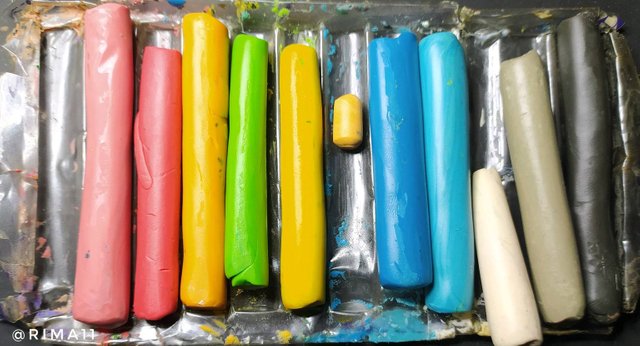Hi!
Welcome to my blog.
As always, every Saturday I share with you what I have learned in my creative week. The tips and tricks section this week will be a little different because I have not been drawing often but I started to practice modeling with plasticine.

As I mentioned in a previous post, I found this set of playdough in an old drawer. I guess they are at least 5 years old. The plasticines were mixed up, with a dry appearance, and looked like they were ready to be thrown away.
However, I was patient and wanted to give them another chance. This taught me to recover the malleable consistency that characterizes them and therefore allowed me to model with them.

The first thing I did was to take a small metal knife, you can also use a spatula and began to separate them by color. After having done this I saw how they were still dry and contaminated with the colors of the other plasticine.
I then began to knead each color separately with force for at least 1 minute and that's where the magic happened. The playdough itself began to generate moisture and the colors that were contaminating the bars began to mix enough to disappear.
The white plasticine was the most affected concerning color contamination, however, it was possible to obtain a good consistency and acceptable shade to work with.

Thank you so much for stopping by.
With love,
Rima.

ESP
¡Hola!
Bienvenidos a mi blog.
Como siempre, cada sábado comparto con vosotros lo que he aprendido en mi semana creativa. La sección de trucos y consejos esta semana será un poco diferente porque no he estado dibujando a menudo pero he empezado a practicar el modelado con plastilina.

Como ya comenté en un post anterior, encontré este juego de plastilina en un viejo cajón. Supongo que tienen al menos 5 años. Las plastilinas estaban mezcladas, con un aspecto seco, y parecían listas para ser tiradas.
Sin embargo, tuve paciencia y quise darles otra oportunidad. Esto me enseñó a recuperar la consistencia maleable que las caracteriza y, por tanto, me permitió modelar con ellas.

Lo primero que hice fue coger un pequeño cuchillo metálico, también se puede utilizar una espátula y empecé a separarlas por colores. Después de haber hecho esto vi como aún estaban secos y contaminados con los colores de la otra plastilina.
Entonces comencé a amasar cada color por separado con fuerza durante al menos 1 minuto y ahí es donde ocurrió la magia. La plastilina en sí comenzó a generar humedad y los colores que estaban contaminando las barras comenzaron a mezclarse lo suficiente como para desaparecer.
La plastilina blanca fue la más afectada en cuanto a contaminación de colores, sin embargo, se pudo obtener una buena consistencia y un tono aceptable para trabajar.

Muchas gracias por pasar por aquí.
Con cariño,
Rima.
